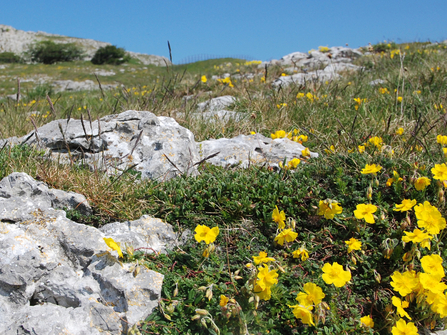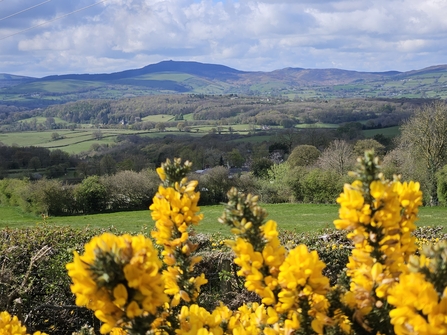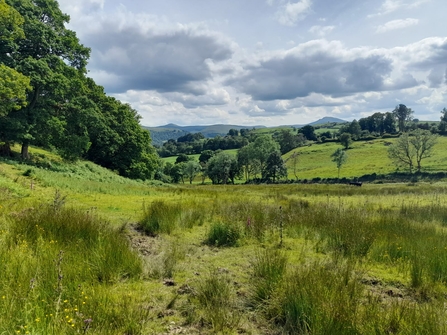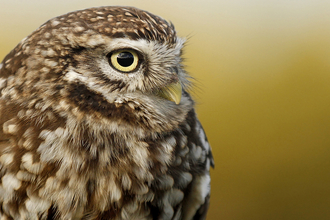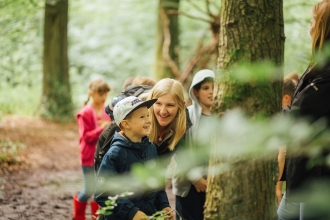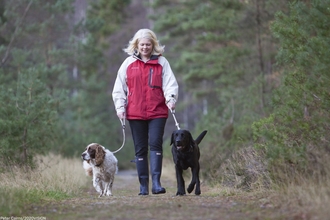Come walk with us!
What better way to keep fit, discover new places and embrace nature than walking or hiking? Whether you are looking for a walk that lasts until sunset, a yomp through dense vegetation or a trek through some of the most remote and wild trails, we've got plenty of inspiration here.
You could enjoy a circular route taking in one of our nature reserves, enjoy an audio trail and learn about local heritage and wildlife, or come along to a walking event with one of our expert wildlife guides.
Enjoy a wild walk in beautiful North Wales
The three circular routes below take you through one of our nature reserves as well as the surrounding countryside.
Each walk has full details of the route and information about the area and local wildlife. You can print off the route at home or view on your phone. We recommend you take an OS map with you too and always let someone know where your going if you're on your own. Remember to wear suitable clothing for the weather and appropriate footwear.
Gwaith Powdwr Nature Reserve, near Penrhyndeudraeth
Enjoy the varied wildlife of this former explosives factory, from newts to nightjars; then join the beautiful Ardudwy Way to the iconic church at Llandecwyn, with breath-taking mountain and coastal views.
Although the walk is mostly based around fairly standard countryside terrain, you will encounter some steep gradients (including steps within Gwaith Powdwr) and uneven ground.
1-4 hours
OS Explorer Map OL18
1-6 miles (2-10 km)
https://www.northwaleswildlifetrust.org.uk/nature-reserves/gwaith-powdwr-nature-reserve
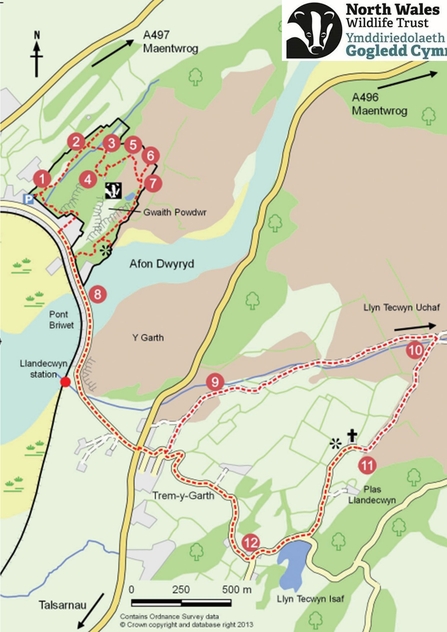
©NWWT
Directions
Take the road out of Penrhyndeudraeth towards Pont Briwet (the toll bridge to Harlech). Take the first road into Cooke’s Industrial Estate, following it for approximately 80 metres to the reserve gates and parking here (SH 616 388). Alternative parking is available further down the road towards Pont Briwet (SH 618 384).
Start
1. Walk straight into the reserve on the tarmac path and turn left at the ‘History of Site’ sign. Among the lovely mature oaks you may see pied flycatcher before the leaf canopy fully opens in spring. Nuthatch and treecreeper also frequent the wooded areas.
2. Stay on the concrete track, which climbs steadily. Where the paths split, turn right, and head uphill towards the Explosives Packing Shed – it’s hard to believe this site was once the biggest explosives factory in Europe! Look for butterflies on the non-native buddleia.
3. Turn right again, still walking uphill, to the Winding Shed. (It’s worth looking inside.) Note the oak and silver birch trees and regenerating holly.
4. Next, take the left-hand tarmac track, passing building T4 which hosts many species of bats, including lesser horseshoe and pipistrelle. Turn left, following the path through a mix of honeysuckle, bramble, bracken and mountain ash (rowan). Carry on past the pond on your right; a good habitat for damselflies, dragonflies, newts and grass snake.
5. The next building, with the red door, is the Explosives Storage Shed; built from strong concrete bricks to contain any accidental explosion. Passing the building, take the steps up to the right, bringing you to the top of Gwaith Powdwr. Here you will find a colourful combination of heathland plants: purple bell heather, pink cross-leaved heath and yellow tormentil. This open habitat is good for slow-worms, which like to shelter from the sun beneath stones. Take advantage of the well-placed bench to enjoy the panoramic views of Snowdonia, the magnificent Dwyryd estuary and Harlech castle.
6. Turn left to visit the Pendulum Shed, where the strength of the explosives were tested until 1983. It’s now a good place for barn owl and nesting swallows! The open heathland here is ideal for nightjar, which can be heard ‘churring’ at dusk during the summer – these ground-nesting birds are much more easily heard than seen!
7. Retrace your steps to return to the main path, noticing common cotton-grass in the wet area. Turn left on reaching the main path, which descends alongside lovely views over the valley. Take a detour to the right to visit the Settling Pool – you may see the impressive emperor dragonfly. Continue down the hill, letting the track lead you out of the reserve. Turn left into the picnic area for great winter birdwatching on the estuary.
8. To extend the walk, continue left onto the Wales Coast Path, crossing the estuary on the road bridge. When you reach the A496, cross carefully and pick up the winding lane going straight uphill from the settlement of Trem-y- Garth. Round the first corner, follow the footpath signs left to take the Ardudwy Way (also signed, in blue, ‘Circular Route’).
9. The wide track is pleasant, with butterflies and micro-moths enjoying the sheltered air. As the habitat opens out, look for stonechat, linnet and whitethroat and listen for the famous ‘little bit of bread and no cheese’ song of the yellowhammer – you may spot this brilliant yellow, but increasingly scarce bird singing from a tree top.
10. As you climb, the valley narrows, eventually bringing you to Llyn Tecwyn Uchaf reservoir – kestrels breed on the cliffs and red-breasted merganser on the lake. To continue on your route, retrace your steps to the metal gate and take the narrow lane to the church, keeping the wall on your right. Look for star moss, bilberry and heather species; and numerous lichens on the stone wall. You will begin to get glimpses of St Tecwyn’s Church and more amazing views across the estuary.
11. Take the small lane which swings right towards the church – you can stop and visit if you’d like. Continue down the lane: the stone wall is impressive, with bilberry, ferns, blackthorn and oak growing between the boulders. On the left, you pass the idyllic Llyn Tecwyn Isaf, with dragonflies and damselflies hovering over the water lilies on the lake’s surface.
12. Continue down the winding lane, where you may see great spotted woodpecker; turning right when it splits. This eventually returns you to Trem-y-Garth and back along the road to Gwaith Powdwr. Once you have crossed the road bridge, pass two gates leading into Gwaith Powdwr but take the third entrance, turning right and passing Grays Waste. Once in the reserve, turn left, taking the grassy path. Concrete steps take you steeply up through woodland to an area of rock and gorse. Turn left in the small glade and the path winds its way back down to the main reserve entrance.
Minera Quarry Nature Reserve, near Wrexham
A walk of diverse habitats and landscapes, including stunning flower-rich limestone grassland and panoramic views from Esclusham Mountain. There’s even a chance of seeing black grouse!
Read before you leave: You will encounter some uneven ground and steep slopes, with areas of exposed moorland. Be aware of mountain bikes on tracks around Llandegla Forest.
4-6 hours
OS Explorer Map 256
7.5 miles (12.2 km)
https://www.northwaleswildlifetrust.org.uk/nature-reserves/minera-quarry-nature-reserve
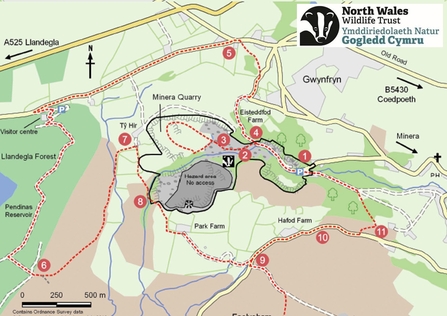
©NWWT
Directions
From the A483, just west of Wrexham, take the A525 toward Ruthin. Follow the road through Coedpoeth and, as you leave the village, turn left onto the B5426 (signposted Minera/World’s End). Take the right turn directly opposite Minera Aided Primary School, continue past St Mary’s Church and head around a sharp left bend. Take the first left onto Maes-y-Ffynnon Road and follow it until you come to the reserve’s small car park (SJ 258 519).
Start
1. With the river on your left, enter the nature reserve through the gate at the end of the car park. Continue along the track – look for old lime kilns and notice the regenerating hazel, birch and willow.
2. Carry on past the footbridge and Aber Sychnant (Welsh for ‘dry river’ and often aptly named); continuing along the track through the gate into the open quarry area. Enjoy the awesome orchid displays in spring and summer.
3. Keep walking towards the intriguing cliffs at the back of the quarry. At the cairn (pile of stones), head right and, when you reach the pond, cross the ditch on your left then immediately cross a second ditch to your right. Follow the grassy path uphill towards the distinctive craggy cliff top. Turn left through a gate and walk along the grassy path as it sweeps downhill to another gate. This sheltered grassland is full of wildflowers, butterflies and colourful five-spot burnet moths feeding on the thistles. Bear right after the gate and follow the path across the grassland back to the pond. Retrace your steps to the footbridge at Point 2.
4. At the two large boulders, turn left through a gate and follow the wide track through the woods. Smell the pungent wild garlic and notice coppiced hazel mixed with ash and willow. Stay on this track, climbing uphill.
Go through a gate and bear left along the lane. After a short distance, a finger-post directs you left into a field. Walk uphill through the field, keeping the trees and bracken on your left. Head for the stile in the corner of the field (beside the buildings) and on to a road.
5. Turn left along the road and almost immediately left on to a quiet lane, continuing for 1 mile. When you reach signs for Llandegla Forest Visitor Centre, go left up to the Centre and you will find a café and toilets (closed Mondays). Take the path to the left of the Centre and follow the waymarked Black Grouse Trail (purple). Enjoy the clean, pine-scented forest fragrance. After approximately 1.4 km (almost 1 mile), you reach a forestry track. There is a wooden post on the left (with ‘9 km’ on the back) and several other marker posts opposite. Cross straight over the track and continue along the path until you reach the black grouse sculptures. Climb over the stile onto open moorland – this is prime habitat for seeing black grouse.
6. When the path forks, take the left-hand route. Notice the mix of typical upland moorland plants: bell heather, ling, cross-leaved heath, gorse, bilberry and tormentil. Watch for stonechat perched on top of gorse bushes and, in July, pick juicy bilberries. At the stone wall, follow the waymarker along the wall to Tŷ Hir Farm.
7. At the farmhouse, turn right along the track and through a metal gate into a field. The footpath follows the fence-line on the left. Look out for red kite and high-flying swifts during summer. Follow the waymarkers: over a stile, through a field with a dip and then to another wooden stile with a ditch/stream. In the grassland, notice harebells and listen for linnet and goldfinch. The wet area contains meadowsweet and forget-me-nots.
8. The path winds downhill through willow, mountain ash and hawthorn. Cross the plank over the stream and continue on the narrow path. The next field slopes steeply uphill. Walk under two pylons and follow the fence-line bordering Park Farm (on your left). Turn right onto the farm track and continue up to the tarmac road.
9. Cross the road and take the grassy track up Esclusham Mountain, turning right to reach the trig point and its lovely panoramic views over Wales and England. Retrace your steps to the road and turn right.
10. Continue along the road, ignoring the first footpath sign and walking beneath the pylons. Take the next footpath on the left, before the cattle grid. As you walk downhill, enjoy views of the church opposite and, in autumn, the rich colours of leaves and berries.
11. Pass two large hawthorns and turn left over the wooden stile through the wall. Turn sharp left and immediately right downhill through the bracken. Once in the woods, keep left when you hit another path (following the yellow arrow) and follow the path downwards, through a meadow with orchids, common knapweed, red campion and birdsong. Exit by a big wooden gate and turn left, along the dismantled railway line. Go past the house and back to the car park.
Rhiwledyn Nature Reserve and the Little Orme, near Llandudno
This coastal walk – stunning in summer, bracing in colder weather! – takes you up onto the Little Orme, including the Wildlife Trust’s Rhiwledyn Nature Reserve.
This route is suitable for fit, experienced walkers, and includes steep climbs and descents, uneven and slippery surfaces, and unprotected cliff and quarry edges. Strong walking boots are essential.
1-2 hours
OS Explorer Map OL17
1.5 miles (2.5 km)
https://www.northwaleswildlifetrust.org.uk/nature-reserves/rhiwledyn-nature-reserve
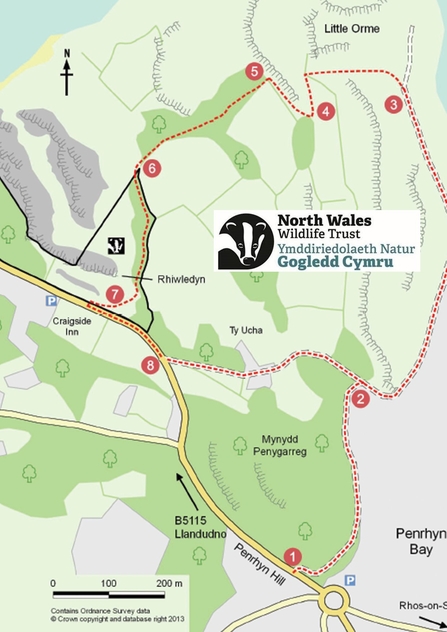
©NWWT
Directions
From Junction 20 of the A55, take the B5115 towards Rhos-on-Sea/Penrhyn Bay. Park where possible within easy walking distance of the roundabout in Penrhyn Bay, where the B5115 meets Glan-y-Môr Road at the foot of Penrhyn Hill.
Start
1. Walk to the roundabout and head up Penrhyn Hill, walking up on the right-hand pavement for about 50 metres. There is a track and public footpath sign on the right, which you follow. You may be lucky enough to hear chiffchaff and blackcap in the spring in the woods on your left.
2. Where the road bends right, ignore the path on the left and continue along the track between the cottages. Go through the kissing gate and continue straight on along the tarmac path to the Little Orme.
3. Where the tarmac ends, follow the gravel path. At the tall waymarker post, go left up the steep path. Stop at the top to admire the view and have a breather! Go left after going through a gate.
4. Follow the path into scrub and you are now on the waymarked Wales Coast Path. Turn right and climb steeply towards a fence.
5. At the corner of the fence, turn sharp left. Follow the path between gorse bushes, where stonechat can be seen and heard in summer. Follow the path gently downwards until you reach another waymarker. Continue straight on.
6. Continue to the wooden kissing gate and information board at the Wildlife Trust’s Rhiwledyn Nature Reserve entrance. On the reserve, you may see limestone-loving plants such as quaking-grass, dropwort and carline thistle. Through the gate, although the main path descends, follow the iron fence to your right and climb the grassy slope. Soon the ground slopes downward and levels out. There is an isolated area of scrub around which white horehound grows: the food plant for the rare horehound plume moth caterpillar. Peregrine falcon, raven, buzzard, kestrel and chough have all been seen here.
Retrace your steps along the fence as far as the kissing gate but turn sharp right to follow the well-defined path downwards through the reserve. Both weasel and stoat have been seen hunting here and woodland birds frequent this sheltered part of the reserve. The path emerges onto grassland overlooking the road. In spring and early summer the limestone hillside is covered by yellow rock-rose.
7. Descend past a seat and an information board towards the kissing gate. Go past the gate onto the grassland at the foot of the cliffs, where you may spot nesting fulmar on the cliffs above you. Return to the kissing gate and go through onto the pavement. Turn left until you reach a drive leading to Ty Ucha on your left.
8. Head down the drive and pass in front of the house, going straight on towards a gate and an old farm building to your left. Continue on this path, between hedges, and descend to the kissing gate. Turn right and retrace your steps along the track back to Penrhyn Hill.
Explore North Wales with our self-guided audio trails
Three circular routes take you through the countryside of North Wales, including one of our nature reserves at Rhiwledyn, near Llandudno. Discover the wonderful wildlife of Halkyn Mountain Common, the Little Orme and Bala - each trail delves into the history, heritage and landscape of the area.
We’ve created a downloadable route map with helpful information you may need to know before setting off. Simply download or print the map at home and listen to the audio clips as you go using your smartphone.
For a safe and enjoyable walk, we recommend bringing an OS map, letting someone know your plans if walking alone, and wearing weather-appropriate clothing with sturdy footwear. Whether you're a history buff, a nature lover, or just up for an adventure, these trails are a great way to explore the wild beauty of North Wales!
Little Orme audio trail, Llandudno
Join us on an audio trail to discover the coastal gem of the Little Orme (Creigiau Rhiwledyn), a fascinating protected site formed by geology and steeped in history.
Come walk with us on the Little Orme
Halkyn Mountain Common audio trail, Flintshire
Join us on an audio trail to explore Halkyn Mountain Common, one of Wales' largest common lands.
Come walk with us on Halkyn Mountain Common
Y Bala audio trail, Gwynedd
Discover the unique wildlife, breathtaking landscapes and rich cultural heritage of Y Bala on this audio-guided journey.
Come walk with us in Y Bala
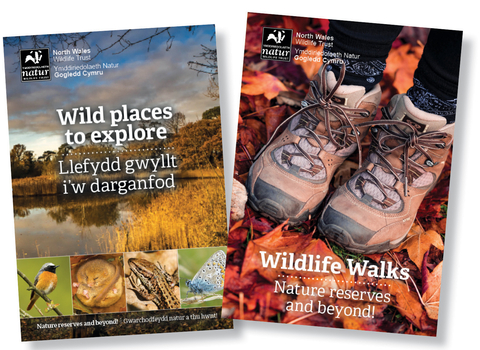
Walk guides
To help you explore we've produced two great guide books ...
Wildlife Walks - there are 23 walks in total, varying from gentle strolls to whole-day wild wanders. Each incorporates at least one North Wales Wildlife Trust nature reserve and beyond! (RRP £7.50)
Wild Places to Explore aims to help you get the most of visiting our nature reserves and coastal hotspots. RRP £7.50 or FREE when joining as a new member.




